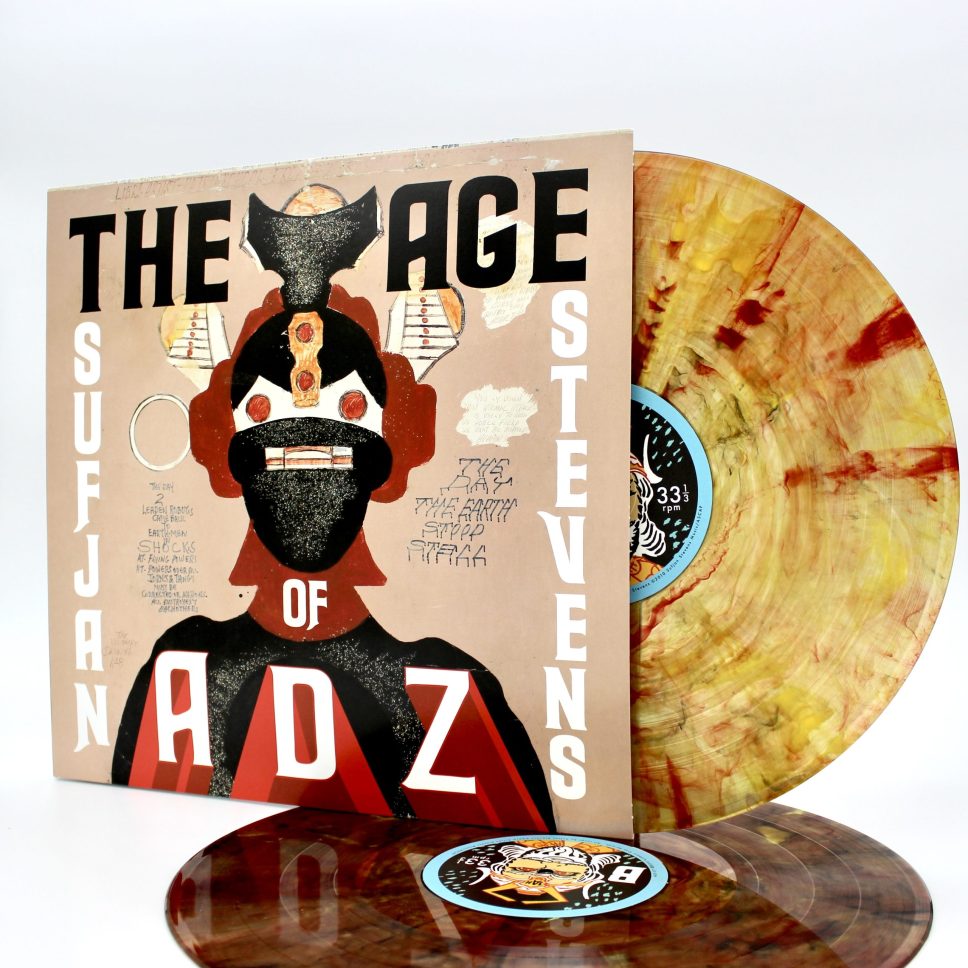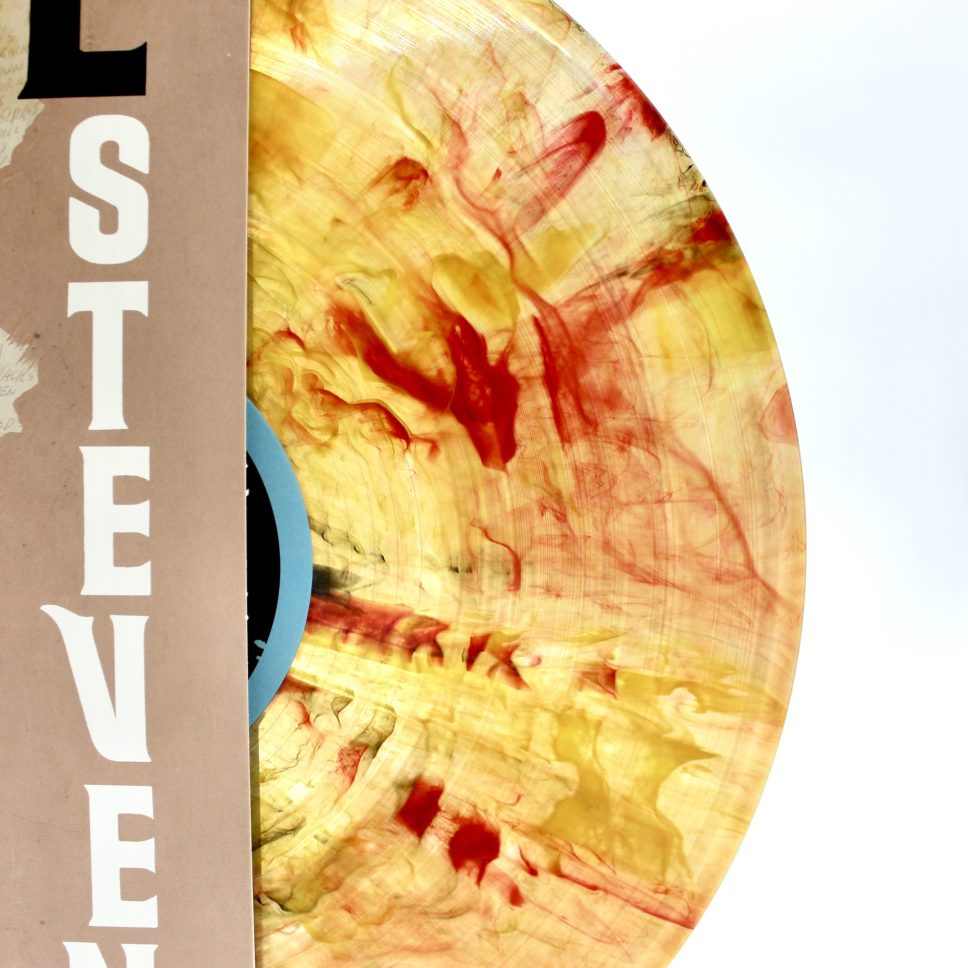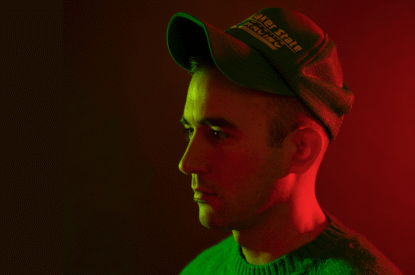Sufjan’s The Age of Adz is back in print on vinyl, and with a new “Vesuvius” edition

We’re excited to announce that after being out of print on vinyl, Sufjan’s The Age of Adz on 2xLP is back in stock at the AKR Store and your local record store.
To celebrate the return of The Age of Adz to vinyl, we’ve pressed a special “Vesuvius” Edition in bold red, orange, and black translucent smoke. Engineer Dave Cooley mastered and cut lacquers for this new round of pressings.
Buy either the black or Vesuvius edition here. A limited number of the Vesuvius edition will also be available in stores.
The Age of Adz began first as an experiment, with Sufjan touring a number of smaller, more intimate venues in 2009 to workshop new songs. These songs included “Age of Adz,” “There’s Too Much Love,” “Impossible Soul,” and also “All Delighted People” and “The Owl and the Tanager,” two songs that would later appear on the All Delighted People EP.
After that tour, Sufjan continued to workshop the songs on his own. But it wasn’t until conversations with friend Scott Ogdon and an introduction to the artwork of Louisiana artist Royal Robertson that the album coalesced into what would become The Age of Adz. (In 2011, we released the film MAKE, directed by Scott Ogdon and Malcolm Hearn, a documentary that tells the story of Royal including artists Hawkins Bolden, Judith Scott and Ike Morgan. You can watch the film here.)
In August 2010, we surprise-dropped the All Delighted People EP on Bandcamp, and then quickly followed up with an announcement of an impending new Sufjan album: The Age of Adz, and opened with “I Walked” as the first single. We promised “an extensive use of electronics,” and followed up on that promise with “Too Much” as the second single in early September.
When Sufjan finally released The Age of Adz in full on September 28th, the album surprised everyone. Most had expected a concept folk record in the vein of Illinois or Michigan; what we got was a direct, strident, vibrant electronic-psych-jam-pop album (Sufjan once himself described The Age of Adz as “music inspired by panic attack”). The Age of Adz was, at first, divisive. (Apparently The Age of Adz “Best New Music” rating at Pitchfork was hard-won.) The Age of Adz is quintessentially Sufjan, triangulating a through-line from Sufjan’s 2003 experimental electronic Enjoy Your Rabbit to 2020’s The Ascension.
Sufjan toured The Age of Adz extensively starting in the fall of 2010 shortly after release date. The tour included Europe and Australia, culminating in August 2011 with twoshows in Prospect Park for Celebrate Brooklyn!. The live show supporting The Age of Adz, choreographed by Jessica Dessner and visualized by Deborah Johnson, was something to behold: light design, smoke, massive wings, mirror balls, beach balls, dancing, balloons, huge custom-made windy dancers TRON-like glow-in-the-dark costumes, and neon gaffe tape everywhere. For many, seeing the The Age of Adz played live helped cement the album as an essential entry into Sufjan’s broader catalog. Bob Boilen of NPR called the Prospect Park show his “favorite concert ever.” Reviewing for Brooklyn Vegan, Rachel Kowal said, “I drank the neon-colored, glow-in-the-dark Kool-aid, and I do not regret it.” Sufjan played the last The Age of Adz show on August 3, 2011, retiring the gaffe tape. Five years after The Age of Adz, Sufjan would release Carrie & Lowell, which alongside Illinois and “Mystery of Love,” have together become the most common entry point to the Sufjan catalog for most fans. Social Club and Khleo Thomas sampled “Vesuvius” in their song “Fade Away,” and in early 2011, a young then-unknown rapper requested to sample “Vesuvius” in an upcoming single. Logic and Juicy J both sampled “All to Myself,” as did Kendrick Lamar for the song “Hood Politics” on his 2015 album To Pimp a Butterfly.
“Futile Devices,” the first track on The Age of Adz, would live its own second life remixed by Thomas Bartlett aka Doveman, alongside Sufjan’s “Mystery of Love” and “Visions of Gideon” for the film Call Me By Your Name.
Thirteen years after its release, The Age of Adz is loved now more than ever. When considered in the context of his twenty-plus year catalog, the album is a testament to Sufjan’s propensity to ignore the rules imposed by genre. The Age of Adz also remains singular; though the music sounds as new in 2023 as it did 2010, there’s never quite been anything like it. In a retrospective on The Age of Adz for Stereogum, Larry Fitzmaurice wrote that, “no one’s tried to do something like [The Age of Adz] since.” But perhaps the most enduring legacy of The Age of Adz isn’t its uniqueness, but that the album speaks to something common, fundamental, eminently human: we all want to feel something, to celebrate life, jubilantly, together with other people, and is there any better way to do that than dancing, sweating in the rain, kicking around beach balls, with Sufjan on stage donned in hundreds of balloons and tinsel, with everyone singing their hearts out “it’s not so impossible?”


Let's Stay Connected
Get updates on the latest Asthmatic Kitty releases.


